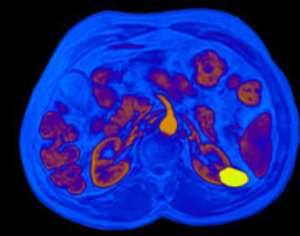
Dialysis and Kidney Disease
Dialysis is an artificial method of filtering the blood and is used when someone's kidneys have failed or are close to failing. Many people with late-stage kidney disease must go on dialysis either permanently or until a donor kidney for transplantation can be found.
Types of Dialysis
There are two types of chronic dialysis: hemodialysis and peritoneal dialysis.
Hemodialysis
In hemodialysis, the blood is pumped through a special machine that filters out waste products and fluid. Hemodialysis is most commonly done during three sessions per week—each lasting three to five hours long—in a hospital, dialysis center, or at home, but it can also be done in shorter, more frequent sessions.
Several weeks or months before starting dialysis, most patients will have an artery and a vein surgically joined, typically in the forearm. This larger blood vessel is called a fistula, and it allows routine access to high blood flow by accessing an artery instead of a vein. Over time, the vein that is connected to the artery will begin to function more like an artery, and the access point for dialysis will be effective. An implanted tube, called an arteriovenous graft, can also be used for the same purpose if an artery and vein cannot be joined.
The most common side effects of hemodialysis are low blood pressure, muscle cramps, and itching.
Peritoneal Dialysis
In peritonealdialysis, the peritoneum—the membrane of blood vessels lining the abdomen—stands in for the kidneys. A tube is implanted and used to fill the abdomen with a fluid called dialysate. Waste products in the blood flow from the peritoneum into the dialysate, which is then drained from the abdomen.
There are two forms of peritoneal dialysis: continuous ambulatory peritoneal dialysis, in which the abdomen is filled and drained several times during the day, and continuous cycler-assisted peritoneal dialysis, which uses a machine to cycle the fluid in and out of the abdomen at night while the patient sleeps.
The most common side effects of peritoneal dialysis are infections of the abdominal cavity or the site where the tube was implanted, weight gain, and hernia.
Dialysis Complications
In addition, people on either form of dialysis still often experience complications caused by kidney failure such as anemia, bone weakening, and swelling or fluid accumulation in the heart or lungs.
Dialysis-related Amyloidosis
In this condition, proteins are deposited on joints and tendons, causing pain and stiffness of the joints. Dialysis-related amyloidosis is common in people who have been on dialysis for five years or more
Written by Shannon Johnson | Published on July 9, 2012
Medically Reviewed by George Krucik, MD




 Akufo-Addo commissions Phase II of Kaleo solar power plant
Akufo-Addo commissions Phase II of Kaleo solar power plant
 NDC panics over Bawumia’s visit to Pope Francis
NDC panics over Bawumia’s visit to Pope Francis
 EC blasts Mahama over “false” claims on recruitment of Returning Officers
EC blasts Mahama over “false” claims on recruitment of Returning Officers
 Lands Minister gives ultimatum to Future Global Resources to revamp Prestea/Bogo...
Lands Minister gives ultimatum to Future Global Resources to revamp Prestea/Bogo...
 Wa Naa appeals to Akufo-Addo to audit state lands in Wa
Wa Naa appeals to Akufo-Addo to audit state lands in Wa
 Prof Opoku-Agyemang misunderstood Bawumia’s ‘driver mate’ analogy – Miracles Abo...
Prof Opoku-Agyemang misunderstood Bawumia’s ‘driver mate’ analogy – Miracles Abo...
 EU confident Ghana will not sign Anti-LGBTQI Bill
EU confident Ghana will not sign Anti-LGBTQI Bill
 Suspend implementation of Planting for Food and Jobs for 2024 - Stakeholders
Suspend implementation of Planting for Food and Jobs for 2024 - Stakeholders
 Tema West Municipal Assembly gets Ghana's First Female Aircraft Marshaller as ne...
Tema West Municipal Assembly gets Ghana's First Female Aircraft Marshaller as ne...
 Dumsor is affecting us double, release timetable – Disability Federation to ECG
Dumsor is affecting us double, release timetable – Disability Federation to ECG
